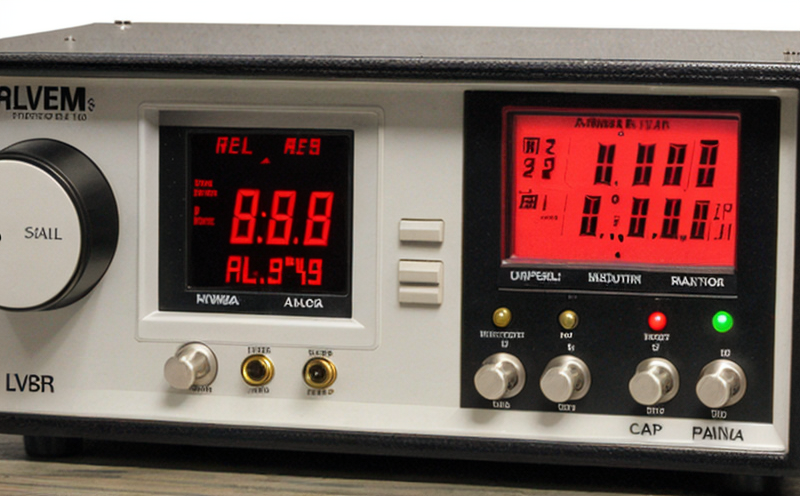ASTM E1454 Calibration of High-Dose Radiation Dosimeters
The ASTM E1454 standard provides a comprehensive framework for calibrating high-dose radiation dosimeters used in various sectors, including healthcare, nuclear power plants, and research facilities. These dosimeters are crucial for ensuring accurate measurement of ionizing radiation exposure, which is vital for compliance with international safety standards.
The calibration process outlined by ASTM E1454 involves several critical steps that ensure the accuracy and reliability of the dosimeter readings. The dosimeters used in this calibration must be capable of measuring high doses of radiation, typically above 200 Gy (Gray), which is higher than typical occupational exposure limits.
The first step in ASTM E1454 involves selecting appropriate reference sources for calibrating the dosimeters. These sources should produce a known and stable dose rate to ensure accurate calibration. The standard recommends the use of secondary standards that trace back to primary standards like those defined by the International Bureau of Weights and Measures (BIPM).
Another key aspect of ASTM E1454 is the setup and measurement process. Dosimeters are exposed to radiation from a known source, and their response is measured using precision instruments. The dosimeters must be placed in specific configurations relative to the radiation source to ensure accurate readings. This step often involves sophisticated equipment such as ionization chambers or calorimeters.
The calibration procedure also includes post-calibration checks to verify that the dosimeters meet the required accuracy specifications. These checks are critical for ensuring that the dosimeters can be used reliably in high-dose environments, where even small inaccuracies could lead to significant safety issues.
ASTM E1454 is widely recognized and accepted across various industries due to its rigorous standards for calibrating high-dose radiation dosimeters. This ensures that the dosimeters are accurate and reliable, which is essential for maintaining compliance with international safety regulations.
The ASTM E1454 standard also provides guidelines on how to handle and store the dosimeters after calibration to maintain their accuracy over time. Proper storage conditions are crucial in high-dose environments where radiation can degrade the performance of the dosimeter if not handled correctly.
Benefits
- Achieve compliance with international safety standards for ionizing radiation exposure measurement.
- Ensure accurate and reliable dosimetry readings in high-dose environments, critical for healthcare and nuclear industries.
- Ease the process of regulatory audits by providing clear documentation of calibration procedures and results.
- Increase confidence in the accuracy of measurements used for safety-critical decisions.
The ASTM E1454 standard is particularly beneficial for facilities that handle high-dose radiation. By following this standard, laboratories can ensure their dosimeters are accurate, reliable, and compliant with international standards, thereby protecting both personnel and equipment from potential hazards.
International Acceptance and Recognition
- The ASTM E1454 calibration procedure is widely recognized and used in many countries around the world. This standard ensures that dosimeters are calibrated to the same high standards, regardless of location.
- A number of countries have adopted ASTM E1454 as a national standard or recommended practice for calibrating high-dose radiation dosimeters. This includes the United States, Canada, and several European nations.
International acceptance of ASTM E1454 is further enhanced by its alignment with international standards such as ISO 8529-1 and IEC 60731-2. These standards provide a consistent framework for calibrating radiation dosimeters, ensuring that the results are comparable across borders.
The widespread use of ASTM E1454 also facilitates easier trade between countries by ensuring that calibration procedures and results are understood and accepted worldwide. This is particularly important in industries such as nuclear power and healthcare where international collaboration is common.
Environmental and Sustainability Contributions
The accurate measurement of high-dose radiation exposure, facilitated by ASTM E1454 calibration, plays a crucial role in environmental protection. By ensuring that dosimeters are calibrated accurately, industries can minimize the risk of overexposure to radiation, which could have harmful environmental impacts.
In healthcare settings, accurate dosimetry is essential for optimizing treatment plans and minimizing unnecessary exposure to patients and staff. This not only enhances patient safety but also contributes to more efficient use of resources, which aligns with broader sustainability goals.
The nuclear industry benefits from ASTM E1454 calibration by ensuring that all personnel exposed to high-dose radiation are protected adequately. This reduces the risk of long-term health effects and helps in maintaining a safe working environment for all employees.





